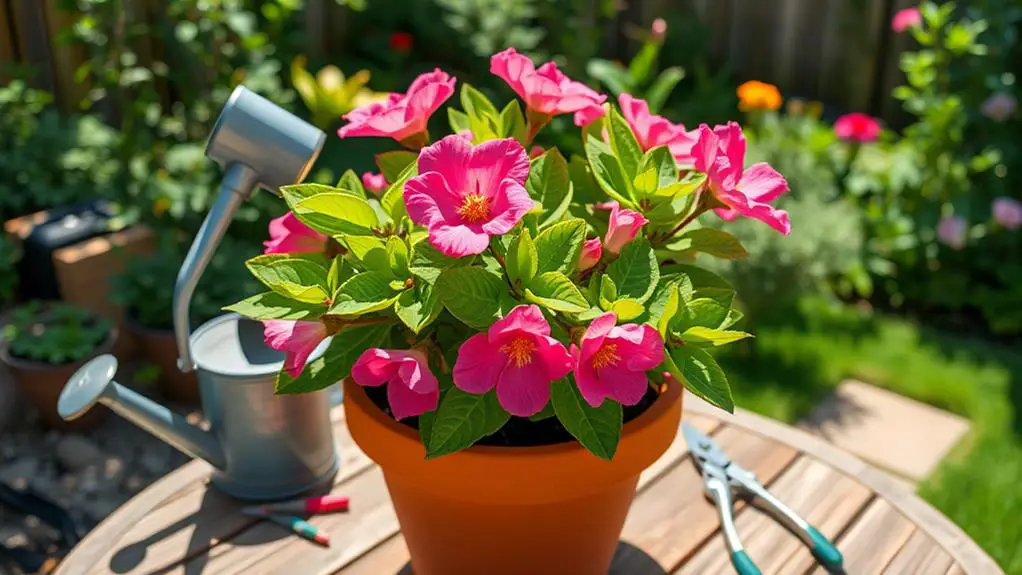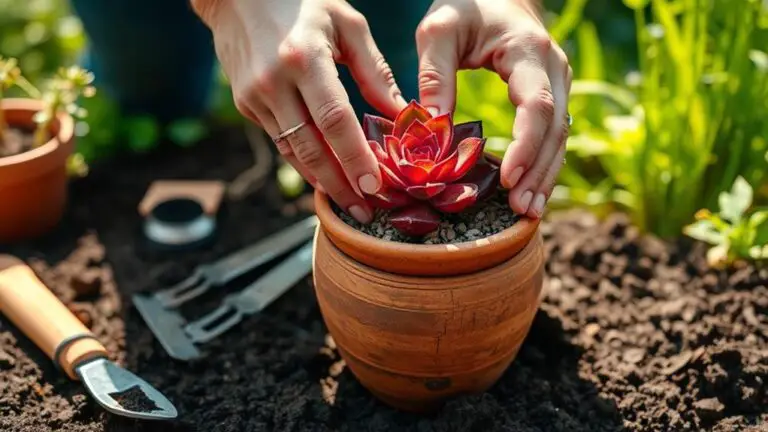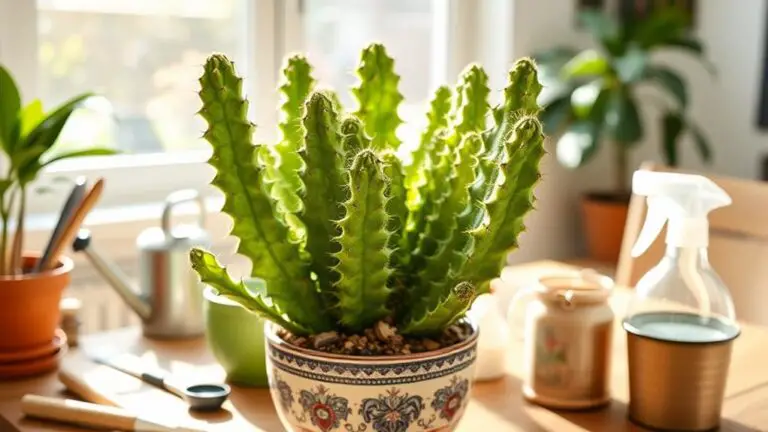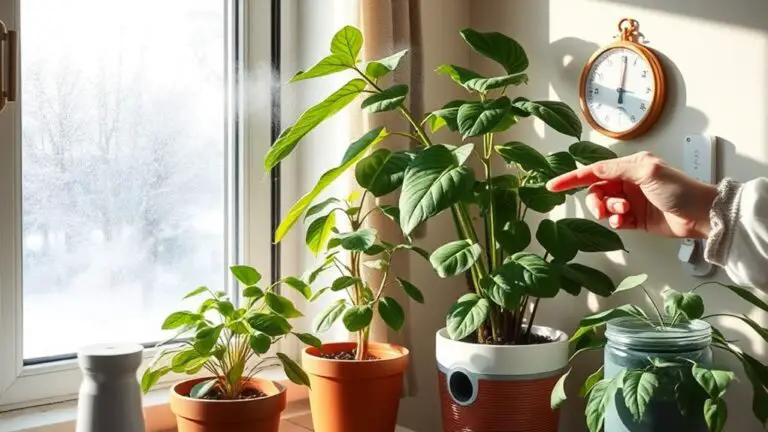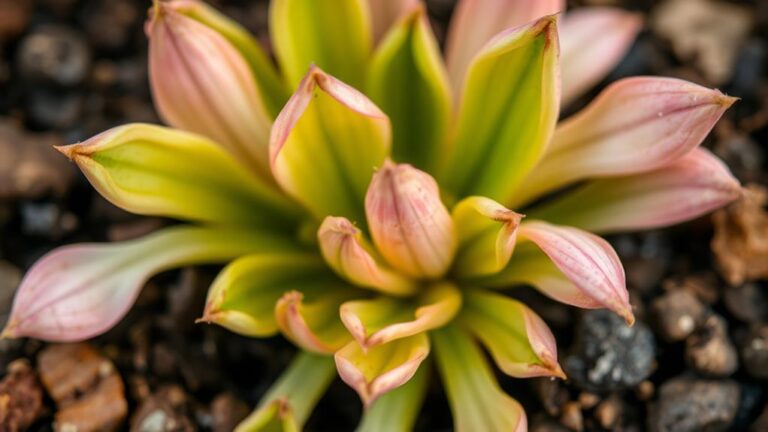7 Essential Steps to Care for Your Adenium Obesum Desert Rose
Caring for your Adenium Obesum Desert Rose involves a precise blend of sunlight, soil, and water management. You need to guarantee it gets at least six hours of direct sunlight daily, but that's just the beginning. The right soil mix and proper watering techniques play vital roles too. As the seasons change, so should your approach to watering and fertilizing. Pruning and regular inspections for pests are essential for maintaining its health and beauty. Wondering how to balance all these factors to keep your Desert Rose thriving? Here's what you need to know to master each step effectively.
Optimal Light Conditions
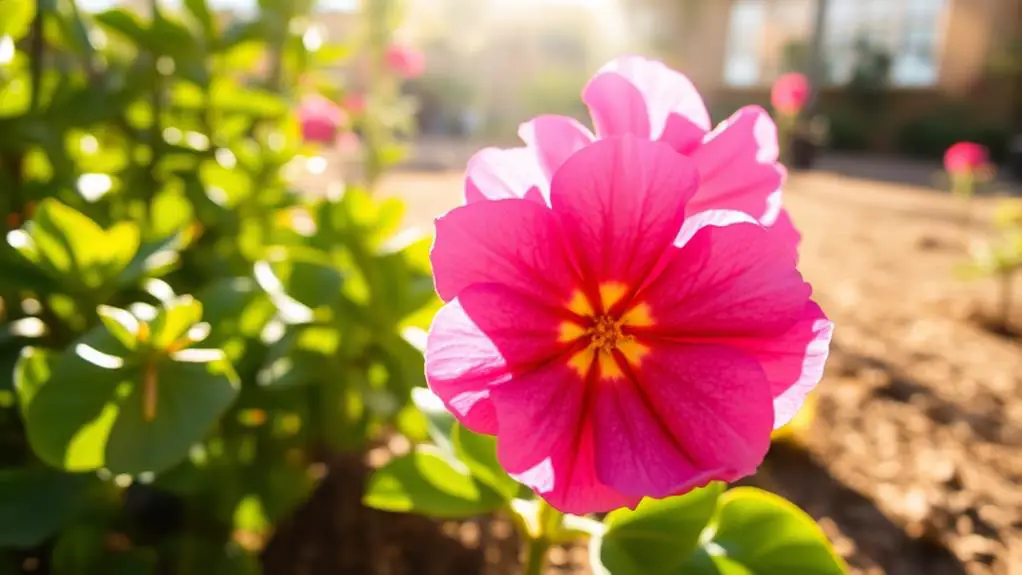
When it comes to ensuring your Adenium obesum thrives, providing the right light conditions is essential. This plant, also known as Desert Rose, needs at least 6 hours of bright, direct sunlight each day to achieve ideal flowering and stay healthy.
Ideally, place your plant near south or west-facing windows for full sun exposure. If natural light is insufficient, consider using grow lights to meet its light requirements.
Remember, gradual acclimation to outdoor full sun is vital to avoid sunburn, as outdoor light intensity is much stronger. Without consistent bright light, your Desert Rose may suffer from poor growth and fewer flowers.
Keep your plant's lighting needs in mind, and you'll see it flourish beautifully.
Ideal Soil Composition
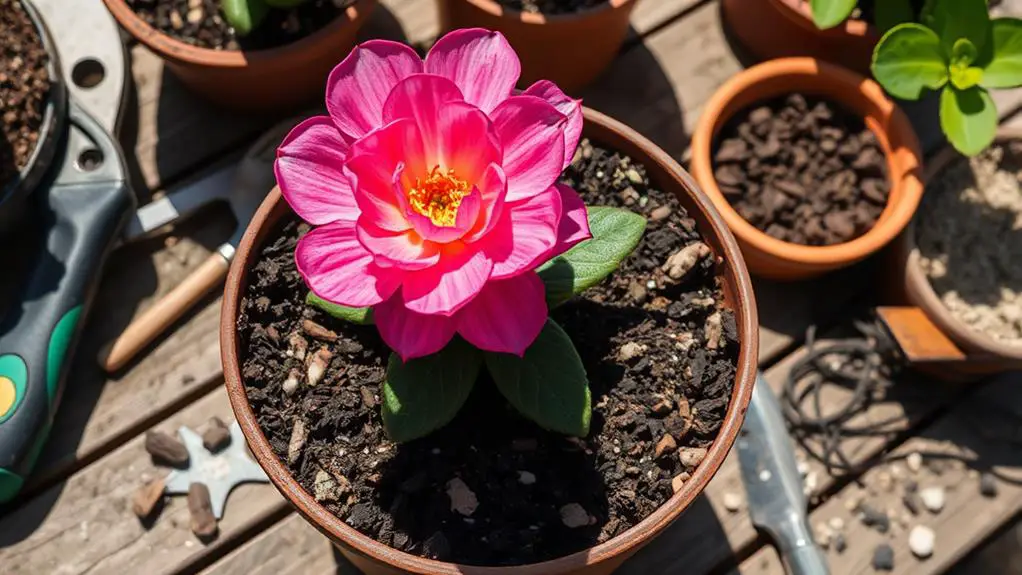
When it comes to choosing the right soil for your Adenium obesum, you'll want a mix that guarantees good drainage and aeration.
Cactus or succulent potting mixes work best, as they prevent root rot by allowing excess water to flow through.
Adding materials like peat or bark can also help improve drainage while providing the nutrients your plant needs to thrive.
Potting Soil Selection
Selecting the right potting soil is essential for the health and growth of your Adenium obesum.
You'll want a potting mix that promotes well-draining soil. This helps prevent root rot, which is a common issue with these plants. A cactus or succulent potting mix is ideal because it offers the right balance of aeration and moisture control.
Look for a soil with a sandy or gravelly texture and a pH around 6.0. Avoid using regular potting soil, as it retains too much moisture and can harm your plant.
Repotting every 1-2 years helps refresh the soil and gives the roots space to grow. Terra cotta containers are excellent choices, aiding in moisture regulation.
Drainage and Aeration
Ensuring proper drainage and aeration is essential for the well-being of your Adenium obesum. These plants need well-draining soil to avoid root rot.
Regular potting soil won't work; instead, use a cactus or succulent mix that includes sandy or gravelly components. This type of soil keeps air flowing around the roots and prevents water from stagnating. Remember, the soil pH should be neutral to slightly acidic, around 6.0.
Here are some key points:
- Use specialty potting mix: Look for mixes with organic peat or bark.
- Ensure containers have drainage holes: This helps excess water escape.
- Avoid regular potting soil: It retains too much moisture.
- Repot every 2-3 years: Fresh soil and space promote healthy growth.
Nutrient-Rich Additives
For Adenium obesum to flourish, you'll need to enhance the soil with nutrient-rich additives.
Start with a well-draining potting mix designed for cacti or succulents. This promotes strong root development and moisture control.
Incorporate organic materials like peat moss or coconut coir to improve soil structure, providing essential aeration and nutrient retention.
Adding perlite or pumice to your mix will boost drainage, preventing the waterlogged conditions that lead to root rot.
Adenium prefers sandy or gravelly soil with a neutral to slightly acidic pH, around 6.0.
Refresh the soil mix every 1-2 years during repotting to maintain nutrient levels and overall soil health.
With these steps, your Desert Rose will thrive beautifully.
Proper Watering Techniques
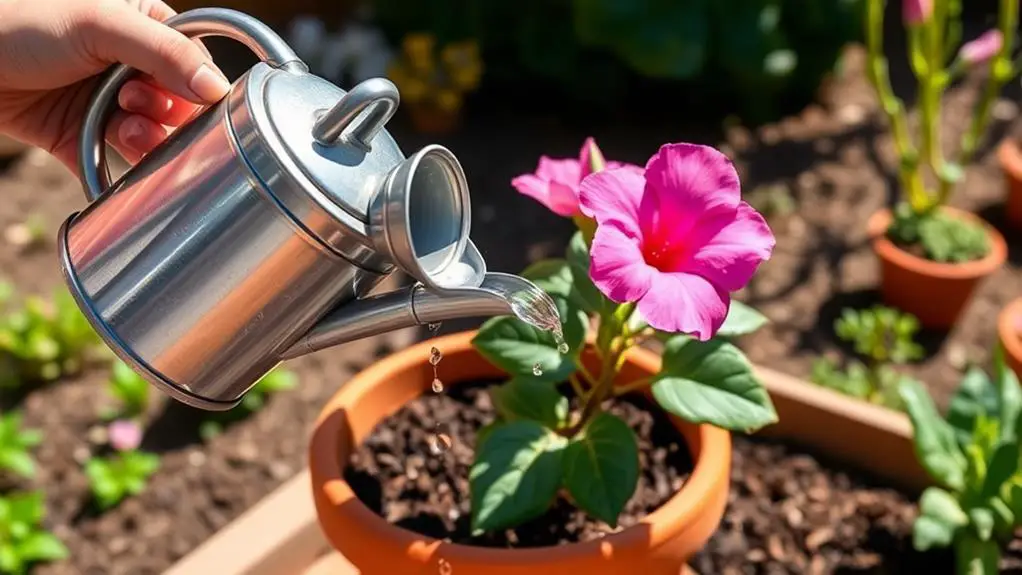
Caring for your Adenium obesum, also known as the Desert Rose, hinges greatly on mastering proper watering techniques. To water the plant correctly, follow these essential steps:
- Water thoroughly, but infrequently: Let the soil dry out completely between waterings. This prevents root rot and is typically needed every 1-2 weeks during the growing season.
- Check soil moisture: Confirm the pot has ample drainage holes. Avoid waterlogging by always checking the soil moisture before watering.
- Observe plant signs: Wrinkling at the base means underwatering; yellowing leaves indicate overwatering. Adjust accordingly.
- Winter dormancy: Reduce watering considerably during winter, as the plant requires minimal moisture until spring growth.
Temperature Preferences

While mastering watering techniques is vital for your Adenium obesum's health, understanding its temperature preferences is equally important.
Adenium obesum loves warm temperatures, thriving best between 65°F and 90°F. If temperatures drop below 50°F, your plant can suffer frost damage. Consistent day and nighttime temperatures above 60°F are essential to keep your plant stress-free and growing well.
When temperatures drop to 50°F, your Adenium enters dormancy. During this phase, it may lose leaves and show reduced activity until warmth returns.
In spring and summer, place your plant outdoors to enjoy the warmer temperatures, but protect it from cold drafts. Keeping these temperature preferences in mind will help guarantee your Adenium remains healthy and vibrant.
Fertilizing Guidelines
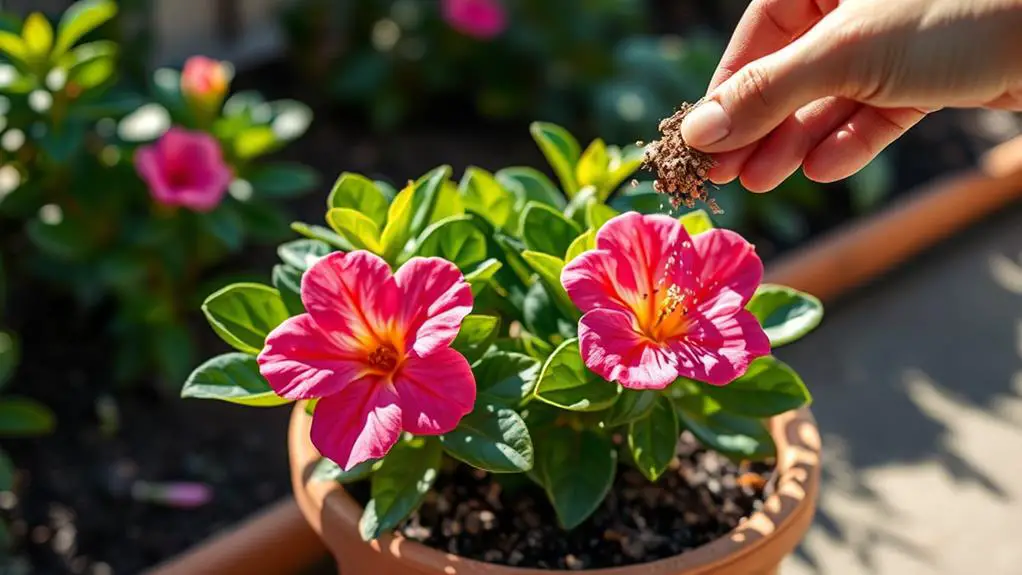
When it comes to fertilizing your Adenium obesum, timing and the right type of fertilizer are key.
During the growing season from spring to summer, use a balanced, water-soluble fertilizer at half-strength every 4-6 weeks to support healthy growth and blooming.
Remember to avoid fertilizing in fall and winter since the plant is dormant and doesn't need extra nutrients.
Optimal Feeding Schedule
To keep your Adenium obesum thriving, focus on fertilizing during its active growing season, which spans from spring to summer.
Use a balanced, water-soluble fertilizer every 4-6 weeks at half-strength to avoid burning the roots. Before fertilizing, verify the soil is moist but not waterlogged to help the plant absorb nutrients efficiently.
Follow these steps for ideal feeding:
- Timing: Fertilize every 4-6 weeks from spring to summer.
- Strength: Use the fertilizer at half-strength to prevent root burn.
- Soil Moisture: Make sure the soil is properly watered but not soaked before applying fertilizer.
- Observations: Watch for signs of nutrient deficiencies like yellowing leaves and adjust your schedule if needed.
Stop fertilizing in fall and winter when the plant goes dormant.
Choosing Right Fertilizer
After establishing an ideal feeding schedule, it's important to choose the right fertilizer to confirm your Adenium obesum remains healthy and vibrant.
Use a balanced, water-soluble fertilizer with an NPK ratio of 5-10-5 during the growing season. This promotes healthy growth and blooming. Apply the fertilizer every 4-6 weeks, but dilute it to half-strength to avoid burning the roots.
Ascertain the soil is moist but not waterlogged before fertilizing to enhance nutrient absorption. You might also consider using a high-phosphorus fertilizer in early spring and early fall to encourage blooming.
Seasonal Feeding Tips
Feeding your Adenium obesum correctly throughout the year is essential for its health and blooming potential. Follow these seasonal feeding tips to keep your plant thriving:
- Growing Season (Spring to Summer): Use a balanced, water-soluble fertilizer every 4-6 weeks. Dilute it to half-strength to avoid fertilizer burn.
- Blooming Phase: In early spring and early fall, switch to a high-phosphorus fertilizer to boost flowering.
- Dormancy (Fall to Winter): Stop fertilizing entirely during these months to prevent nutrient buildup and root damage.
- Monitor Health: Watch for signs of nutrient deficiency, like yellowing leaves, and adjust your feeding regimen if needed.
Always water your plant thoroughly before applying fertilizer to guarantee the roots are well-hydrated and protected.
Pruning and Propagation
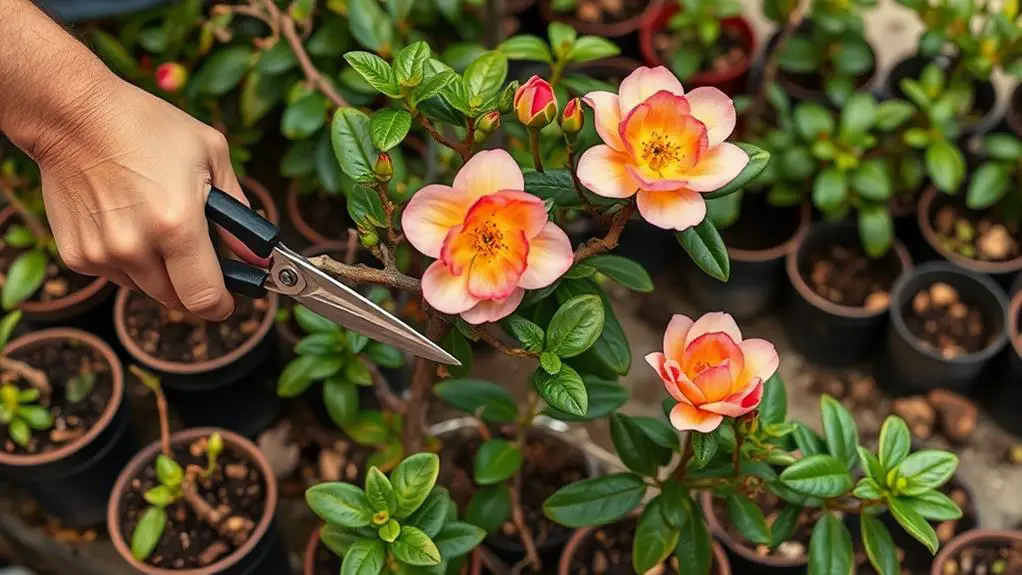
Caring for your Adenium obesum involves thoughtful pruning and strategic propagation to guarantee robust growth and a well-maintained shape.
Regular pruning during the growing season helps your Desert Rose stay bushy and neat. Focus on trimming cold-damaged growth and branches that rub against each other. Make your cuts just above leaf nodes to promote new growth.
For propagation, use cuttings that are at least 6 inches long. Let them dry for 48 hours before planting in well-draining soil. Applying rooting hormone to the cut end before planting can boost success.
Expect new growth within 2-6 weeks if you care for them properly. Don't forget to repot every 2-3 years with cactus potting soil to keep roots healthy.
Pest and Disease Management
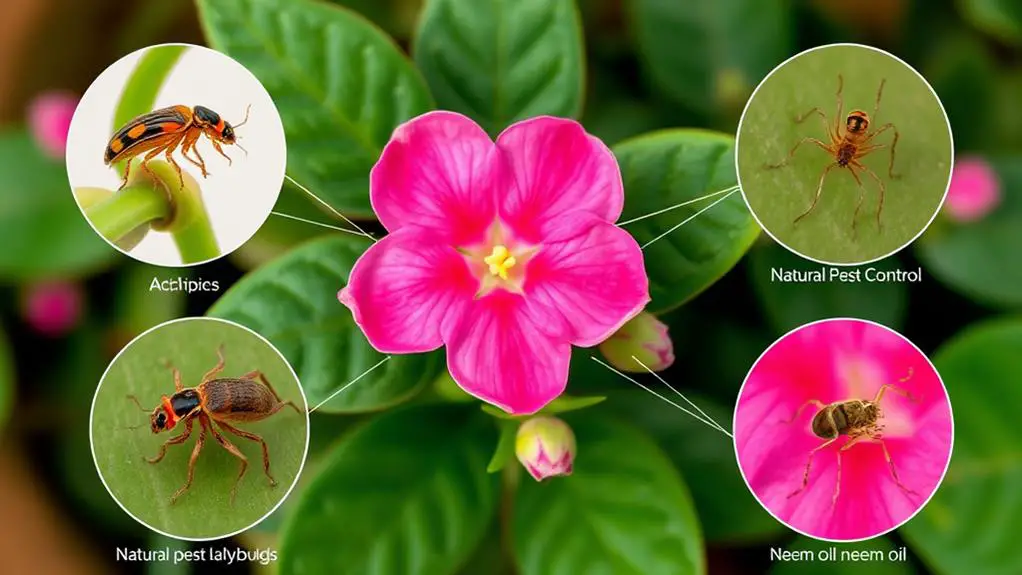
To guarantee your Adenium obesum thrives, it's crucial to stay vigilant against pests and diseases. Regularly inspect your plant for common pests like mealybugs, aphids, and spider mites, especially on the undersides of leaves.
Use insecticidal soap or neem oil to treat infestations, applying every few days until the pests are gone. Be mindful of root rot, which is a serious issue; guarantee proper drainage and avoid overwatering.
Watch for powdery mildew, which appears as blister-like marks on leaves, and improve air circulation to prevent it.
Here's a quick guide:
- Check undersides of leaves for pests.
- Use insecticidal soap or neem oil.
- Guarantee proper drainage to prevent root rot.
- Improve air circulation to combat powdery mildew.
Frequently Asked Questions
How to Take Care of Adenium Desert Rose?
Make certain your Adenium desert rose gets 6 hours of sunlight daily, use well-draining soil, water every 1-2 weeks, let soil dry out, fertilize every 4-6 weeks in growing season, and watch for pests.
How Often Should I Water Adenium Obesum?
You should water your Adenium obesum every 1-2 weeks during the growing season. Let the soil dry completely between waterings. In winter, reduce watering considerably. Always check if the top inch of soil is dry before watering.
How to Make Desert Rose Bloom?
To make your Desert Rose bloom, guarantee it gets at least 6 hours of direct sunlight daily, keep temperatures warm, use a phosphorus-rich fertilizer every 4-6 weeks, and allow the soil to dry completely between waterings.
What Is the Best Fertilizer for Desert Rose?
You should use a balanced, water-soluble fertilizer with an NPK ratio of 5-10-5 for your Desert Rose. Apply it every 4-6 weeks during the growing season, diluted to half-strength, ensuring the soil is dry beforehand.
Conclusion
Taking care of your Adenium Obesum Desert Rose might seem challenging at first, but you've got this! With the right amount of sunlight, proper soil, and careful watering, your plant will thrive. Don't forget to fertilize, prune, and check for pests regularly. Each step is important and brings you closer to a beautiful, healthy plant. Follow these tips, stay patient, and soon you'll enjoy the stunning blooms of your desert rose. Happy gardening!

